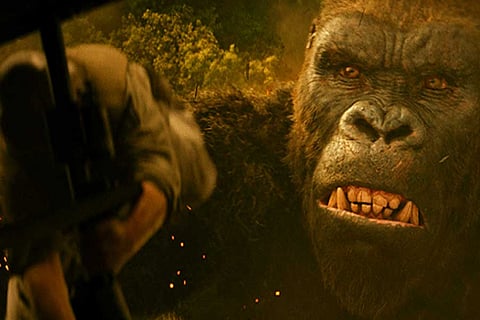
- In-Depth Stories
- Web Stories
- Reviews
- News
- FC Lists
- Interviews
- Features
- FC SpecialsFC Specials

Director: Jordan Vogt-Roberts
Cast: Samuel L. Jackson, Tom Hiddleston, Brie Larson, John Goodman, John C. Reilly
Kong: Skull Island, one of two standalone film-plots about everybody's favourite large-hearted mutant ape, is an unapologetically trashy, formulaic, script-hating, mildly racist and gloriously clichéd monster movie more on the lines of Jurassic World (remix) than Jurassic Park (original). In fact, in true Hollywood-blockbuster tradition, it seems to be proud of how ragingly stupid it is. I'd say it's absurdly entertaining in parts, too – if you play a mental drinking game of downing shots the moment an over-abused 70s-rock-anthem rings out an Apocalypse-Now-starched wartime silhouette, or every time pulpy Samuel L. Jackson's fiery eyes are symbolically juxtaposed against a vividly expressive Kong's. The artful visual concealment of Gareth Edwards' Godzilla be damned, Kong is so relentlessly visible that one almost expects him to break the fourth wall and give an Oscar acceptance speech.
In spirit, this film is more of a sequel to the conventional 'King Kong' legend. Assuming that the lovelorn giant monkey survived the ill-fated climb up the Empire State building, returned to Skull Island and stayed away from human divas and the concept of bestiality for four decades, Kong predictably relies on its texture: the goofy integration of the Vietnam War tailspin, which presumably accounts for a racially diverse bunch of studio-picked human faces (Mexican, Oriental, African, British), which in turn accounts for an early prediction of who will survive and who will be mauled, swallowed, chomped on and torn into fleshy pieces (hint: white skin no good, unless A-listers).
Tom Hiddleston is an expressionless tracker, Brie Larson is an intensely bored photojournalist, ageless John Goodman is destined to die a gruesome death.
That the freshly defeated American soldiers, led by a deluded decorated Lieutenant (Jackson), have their smarting patriotic hearts turn into villainous vapor ("we won't lose this war too!") is vaguely clever, and perhaps the only 'layered' addition to this non-story. Tom Hiddleston is an expressionless tracker, Brie Larson is an intensely bored photojournalist, ageless John Goodman is destined to die a gruesome death. The utterly cool John C. Reilly is the only one in on how to be perpetually stoned on the sets of a movie too drunk on its own history. As a long-stranded World War 2 pilot, he serves as the kooky storyteller to the viewers, designed to convince us that Kong is actually a nice guy. He chuckles like a man smugly aware of how the silly 'island' is chock-a-block with luxurious vanity vans for these brave green-screen crusaders.

I also say 'sequel' because of the way Mr. Kong seems to look at Larson, perhaps reminiscing of the moist cinematic nights he had shared with a blonde actress in the 1930s. Throw in a bunch of strategically placed CGI-created island creatures, and you have little more than a monotonous kiddie videogame.
Each time the camera cuts to any of these faces, they appear as if they were high school jocks feigning danger in their annual freshman-year stage play. The fear isn't real, and it hasn't been real ever since advanced computer graphics took over as the 'soul' of this genre. The creatures can be breathtaking, while the humans begin to resemble artificial vaudeville machines. A bunch of atmospheric set pieces – notably one that involves Kong's ugly adversaries in a graveyard of bones – serve as visually extravagant distractions, determined to overcompensate for the clownish assortment of these character stereotypes.
I never quite thought we'd be at a stage where, 12 years after Peter Jackson's terrifically mounted King Kong, the sheer epic-ness of old-school monster movies is consistently compromised by the minds that imagined these secret worlds. It's difficult to be impressed by spectacular action and warring behemoths anymore; a showdown with an evil-looking creature (which looks the result of a blindfolded CGI team merging random body parts together) bears the familiarity of two brawlers in a British pub after an ill-tempered Manchester derby game.
The heart of it all lies in its style, in its money-shots and mischievous transitions, instead of its stakes: it honestly didn't matter who perished, including our hairy protagonist, because of the tired personality and futile geography of his enigmatic island.
This culture of making everything new a geeky homage to the past is perhaps a ruse to conceal the creative bankruptcy of this generation's filmmakers
Not surprisingly, the director, Jordan Vogt-Roberts, much like contemporaries Colin Trevorrow (Jurassic World) and Gareth Edwards (Godzilla), debuted with a low-budget critically acclaimed indie, before being usurped by the ambition of captaining a moneyed studio franchise. Given this recent trend of young original filmmakers using their indie darlings as stepping-stones to 'revolutionize' an existing landscape, I don't quite see this as a promotion.
As long as Kong, Godzilla (Kong v/s Godzilla slated for a 2020 release), modern dinosaurs and flying fish keep thriving on their derivative monopoly of scale, Marvel and DC will continue to bombard us with equally derivative 'futuristic' extended-universe zip-zap-zoom sagas. There will be diehard fans on both sides of the border, but deep inside even they will realize the overworked nostalgia of cheering for reruns again and again. Guillermo del Toro, are you listening?